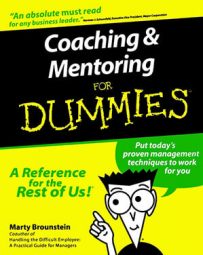In coaching for performance and career development, managers develop employees by strengthening and growing employees' skills, knowledge, and abilities. As a result, employees can perform self-sufficiently and at high levels. This is all done in the context of maximizing the resources being paid for to get high productivity in return.
Coaching for performance and career development involves a five-step process.
Assess employee competencies and explore needs and interests.
The following questions represent the issues you want to explore with your employees.
What job-related skills, knowledge, and abilities does the employee have — from the ones of strength to the areas of weakness?
What does the employee need for future growth?
What are the employee's interests for performance and in career development?
Clarify the organizational needs and competencies required.
Arm yourself with two sets of data:
What are the challenges and needs of your department, currently and in the future?
What are the needs of the business overall, currently and in the future?
Provide this information to your staff members so they see two main points:
What is important in running the business from a group level and organizational level.
What direction are the group and company headed?
Analyze and prioritize career issues and development needs.
Determine what to work on for employee development to meet business needs — create a match between employee and company needs that makes the development effort relevant. If employees have other interests unrelated to their current job situations or future growth in the organization, redirect the focus to what is relevant and needed.
If improvement is needed in an area of performance, start there before worrying about working on growth. In essence, get the foundation of the house in order before you work on adding new floors to it.
Mutually construct a development plan to target the selected needs.
This involves building a road map together to formalize and focus the development efforts. The plan allows both you and the employee to manage the development effort. You're building involvement and accountability from the get-go.
Don't be overly ambitious and target a bundle of areas for development. Usually one or two is enough and is all that you support with each staff member. You want to take a long-term view with your development efforts. It's not about what assignments or tasks you need to learn to do for next week. It's about growing employee skills and capacity levels for bigger and better performance.
Follow up to review progress and support ongoing development.
This step makes the process continuous and focuses on getting results that benefit both the employee and the business. It ties development to a regular part of employee performance — not an extracurricular activity that everyone forgets about when they go back to work.
Set the frequencies for checkpoints at a reasonable level. Weekly check-ins for a long-term effort usually aren't relevant. Tying into the checkup review you have each quarter may work just as well. Tailor to what best fits the development plan.
This five-step process provides you a focused approach for coaching for career and performance development with your employees. It also defines how both parties play a role in helping to make employee growth happen — the employee is the driver, and you are the supporter.

